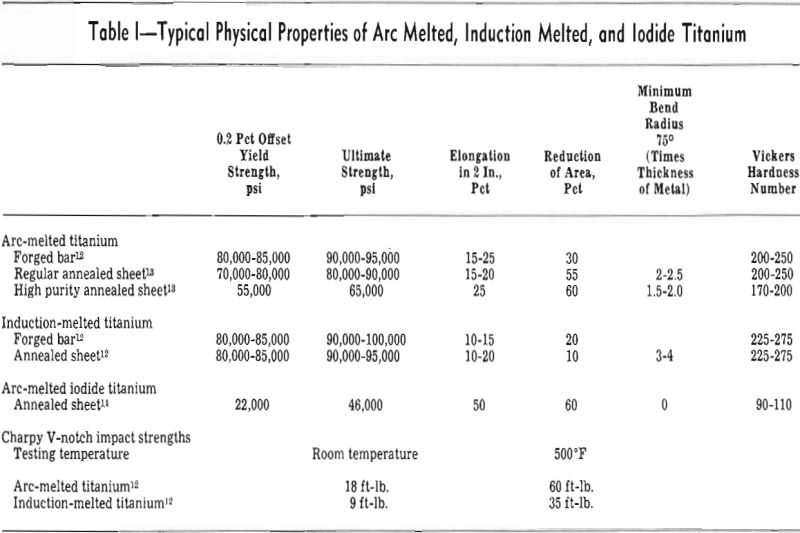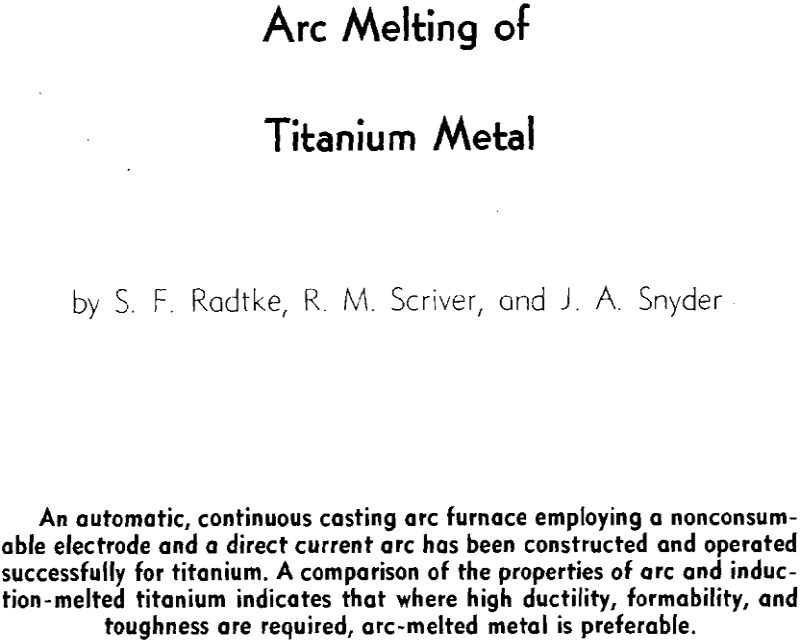 Because of the reactivity of titanium metal with all known refractories and the common atmospheric gases, melting of the metal presents numerous problems. It is necessary to provide an inert atmosphere in the furnace as well as a crucible material that will not react with the molten metal, if a ductile ingot is to be produced. Two special furnaces have been developed that meet the requirements and one, the induction heated graphite furnace, has been described in some detail.
Because of the reactivity of titanium metal with all known refractories and the common atmospheric gases, melting of the metal presents numerous problems. It is necessary to provide an inert atmosphere in the furnace as well as a crucible material that will not react with the molten metal, if a ductile ingot is to be produced. Two special furnaces have been developed that meet the requirements and one, the induction heated graphite furnace, has been described in some detail.
In the development of an arc furnace for melting titanium, a manually operated pilot model was constructed first. From this unit, techniques for feeding titanium sponge, characteristics of inert atmospheres, and the consumption rates of various types of electrode materials were determined. It was found that crushed titanium sponge could be fed at a controllable rate to the furnace chamber by means of a vibratory feeder either continuously or at desired intervals. An atmosphere of argon or helium proved to be satisfactory for manual as well as automatic melting procedures.
The furnace proper is entirely water-jacketed, including the crucible, furnace neck, furnace head, and electrode assembly. An auxiliary pump circulates water through the system, the major portion of which is recycled. The ingot, 5¾ in. in diam, may be cast continuously by retracting it at a uniform rate by means of a hydraulic ram. Because of the desirability of having a rugged crucible that could stand constant use without frequent replacement, thin- walled copper crucible sleeves were replaced with extra heavy sleeves of copper pipe. This latter type of crucible has proved very satisfactory.
The typical melting cycle is carried out in the following manner. A stub ingot is secured into the ingot retractor and raised into the crucible cavity, and a charge of sponge is loaded into the feed hopper. Mastic material is employed to seal the space between the ingot and the crucible, thus permitting evacuation of the system.

After several flushings with an inert gas, the atmosphere finally is admitted until a slight positive pressure is obtained. At this point, the generators are started, and the melt switch thrown in. The electrode, based upon a pre-set voltage, is lowered automatically to strike an arc. After the arc is struck, the electrode rises until the desired potential is attained. The electrode, driven by the rotor motor, begins to rotate and move the arc over the ingot surface.
The furnace operation is believed safe. Should the crucible be burned through for any reason, the pressure developed by the steam generated would break either the large rupture disk in the feed hopper or in the furnace head. At the same time, the vapor formed would extinguish the arc and open the electrical circuit.
Alloys of titanium as well as pure titanium can be melted in this furnace. Sponge of relatively uniform particle size usually is tumbled with the powdered alloying elements in an inert atmosphere. After blending, the alloying powders fill the interstices of the sponge and leave little if any residual powder in the blender.
If arc-melted ingots are allowed to cool to room temperature before being removed from the furnace, the top of the ingot appears as a bright, shiny surface with the grain boundaries clearly delineated. When a hot ingot is removed from the furnace, a thin oxide film is formed on the entire ingot surface. The oxide film formed on continuously cast ingots is very thin and is not considered objectionable. For this reason, and the fact that all subsequent hot-working of the ingot is done in air, no effort has been made to prevent oxide film formation during the continuous casting operation.


